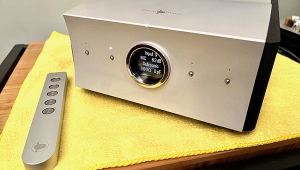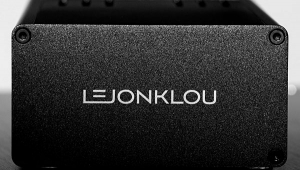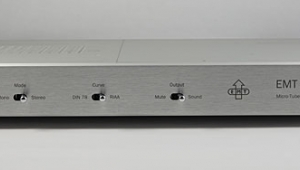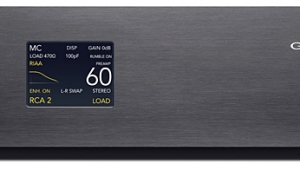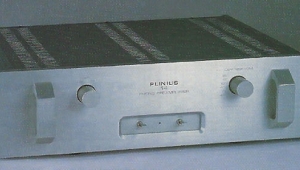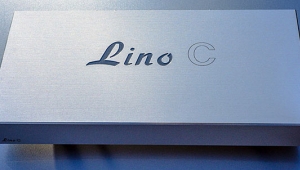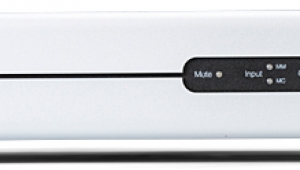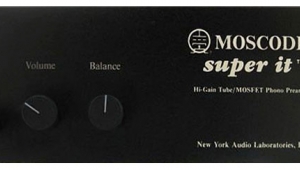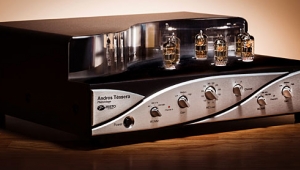| Columns Retired Columns & Blogs |
AQVOX Audio Devices Phono 2Ci phono preamplifier
The German company AQVOX Audio Devices has produced an innovative moving-coil/moving-magnet solid-state phono preamplifier, the Phono 2Ci, that's as intriguing for its technology and performance as it is for its relatively low price: $1400. The zero-feedback, op-amp–free circuit uses a compact switch-mode power supply that's built into the chassis and features conventional voltage gain for moving-magnet cartridges via its RCA jacks, and current gain for moving-coil cartridges through the balanced XLR inputs. Rear-panel switches select between RCA or XLR inputs and offer a convenient ground lift. Either the single-ended or the balanced outputs can be used with either input. Unfortunately, the tight spacing of the RCA input and output jacks, which are mounted on the circuit board, will somewhat limit your choice of cables: Pairs of thick-barreled plugs will have difficulty fitting.
Footnote 1: As I have mentioned in reviews of other phono preamplifiers featuring the Neumann modification to the RIAA curve, I have philosophical problems to this change. It corrects something that, in my opinion, doesn't need correction.—John Atkinson

The Phono 2Ci's build quality and published specs are impressive: no integrated circuits in the signal path, zero feedback, 68dB gain max into the RCA inputs, between 55 and 75dB gain into the balanced input (depending on the cartridge impedance), and impressively low distortion and noise figures.
The RIAA circuit implements the Neumann time constant of 3.18µs, equivalent to a boost above 50kHz. In the lacquer-cutting process, the lows are cut and the highs are boosted; when you play the resulting LP, your phono preamp's RIAA filter reverses this process, hopefully producing a flat response. However, because allowing the HF boost to continue to infinity can burn out the cutter head's expensive coils, the Neumann cutter head employs a 50kHz rolloff that many, if not most, phono preamps don't compensate for. Can you hear 50kHz? No, but some designers feel that the extension improves the high-frequency response you do hear by reducing phase shift far beyond the upper limit of human hearing (footnote 1).
Among other phono preamps, I used the AQVOX Phono 2Ci during the listening sessions for my review of the Rega P3-24 turntable elsewhere in this issue, for which I used the Rega Elys 1 and Exact 2 and the Goldring Elite MM phono cartridges. I found it a very solid performer: quiet, clean, and well organized, with particularly pristine highs that were neither etchy nor bright. The capacitive loading choices (47pF plus 0, 47, 100, 220, or 470pF) let you tailor the high-frequency response to your liking. The Phono 2Ci's bottom end was not as insistent and extended as that of the Graham Slee Era Gold V, for instance, but its LF performance better complemented the P3-24's somewhat lively low-end heft.
If you use the RCA inputs for voltage gain, the Phono 2Ci is pretty standard fare: DIP switches mounted on the rear panel control gain (+6 or +20dB) and capacitive and resistive loading (1k ohm or 100 ohms). The Phono 2Ci's front-panel controls include a subsonic filter and a pair of stepless gain controls (+0dB to +10dB) that are not output volume controls, but trim pots that control the "gain/preamplification factor," to match cartridge output to gain-stage input. They can be used as balance controls, and even to optimize the sound of individual LPs, depending on how hot these were cut. The setting is "by ear," based on "detail" and soundstaging.
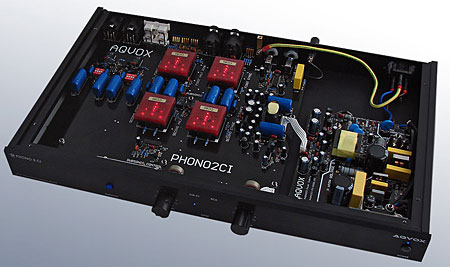
You're won't be buying the Phono 2Ci for its MM section, however. It's the current-gain MC input section that makes this product intriguing, if somewhat tweaky and dependent on associated gear. To take advantage of the current-gain circuit, you'll have to either terminate your tonearm wires with balanced XLR connectors, or (less good) use properly terminated RCA-to-XLR adapters. However, it's critical that none of the cartridge pins contact ground. Most tonearms are so wired, but not all [the Regas have the left channel negative signal lead connected to ground, for example—Ed.] so check first.
And if you're considering using RCA/XLR adapters, you have to be careful. They need to connect the positive and negative phase of the XLR to the inner and outer contacts of the RCA jack and leave the XLR ground disconnected or connected to the turntable ground. Fortunately, I had one of these lying around for a long-running project involving Pure-Vinyl, the company that offers RIAA equalization in the digital domain for Mac users and high-resolution A/D conversion. However, it's better to rewire your tonearm with XLR connectors following the diagram on p.114 of the Pure-Vinyl instruction manual, which can be downloaded with the demo version of the program. I also used a set of Cardas DIN-to-XLR phono cables
A moving-coil phono cartridge is an inherently balanced generator: each coil floats relative to ground (the body). A balanced circuit will reject noise common to both the positive and negative connections, whereas a single-ended circuit will amplify it. Given the minuscule outputs of most MC cartridges, the advantages of a balanced circuit are obvious for noise suppression. Why don't more companies build them? Don't axe me.
MC cartridges may produce tiny voltages, but they output decent amounts of current from a source impedance that is both low and resistive. This is ideal for use with a current-mode input because such an input is nearly a short circuit. Different MC cartridges react differently to being plugged into a current-mode input, in part depending, of course, on the internal impedance, but the short-circuit loading means the cartridge is inherently damped and resistive loading becomes a nonissue.
For whatever reasons, the AQVOX Phono 2Ci's stable, detailed spatial presentation stood out immediately. Having swapped out the tubed Nagra VPS phono stage ($5995, review in the works) for the AQVOX meant that the Nagra's warm, suppleness was gone. But in its place—and for considerably less money—was a startlingly clean, fast, ultradetailed, wide-open, three-dimensional sound that, with judicious use of the front-mounted gain controls, could be tweaked to subtly shift the sound's spatial and tonal balances.
I'm not sure I've ever heard a more transparent phono preamp at any price, save for the Boulder 2008—the "blackness" of the backdrop was startling. If you like tubey warmth and/or voluptuous bass, the Phono 2Ci may not be for you. However, if you like unforced detail and resolution, as if looking through a just-cleaned—or just-removed—window on the action, the AQVOX will deliver that. If you dig Shelby Lynne's Just a Little Lovin' (LP, Lost Highway 80009789-01), you should hear it through the Phono 2Ci. It lost some of the amazing bass weight that at first makes me think I'm playing it at 16.67rpm, but the transparency, focus, and transient clarity were astonishing.
![]()
I've been listening to Einstein Audio's excellent TU-3 cartridge (an EMT-built variant) through a variety of phono preamps, and it has performed well with all of them. But with the AQVOX it reached a state of sonic perfection that could not be denied. Out of a deep blackness, Bill Evans' Quintessence (2 45rpm LPs, Fantasy/Analogue Productions F-9529) produced three-dimensionality and transient perfection that were revelatory—and I don't use that final word lightly. A bit light in Ray Brown's bass? Yes, but the communication of his fingers hitting the strings was unsurpassed.
Classic Records' indispensable reissue of Peter Gabriel's So—the only vinyl edition cut from the analog master tape (Geffen/Classic)—produced astonishing resolution of low-level inner detail. A slight nudge of the gain controls, and there was added midband weight on a huge, wide-open soundstage. The Phono 2Ci's ability to retrieve ambience was remarkable. I don't think I've ever heard So sound this good or reveal so much detail.
Used with moving-coil cartridges in balanced current mode, the AQVOX Phono 2Ci is one of those products that will inspire you to rediscover your vinyl collection. Its sound is transparent, expansive, hi-rez, and ultradetailed, but neither etched nor bright. I wouldn't want it to be my only phono preamplifier, but I sure do want it in my arsenal. If you can spend $1400 on a phono preamp, can easily swap out phono cables, and are willing to invest in a set of your favorites that are properly terminated, you need to experience this innovative product in your system. I'm hooked.
Footnote 1: As I have mentioned in reviews of other phono preamplifiers featuring the Neumann modification to the RIAA curve, I have philosophical problems to this change. It corrects something that, in my opinion, doesn't need correction.—John Atkinson
- Log in or register to post comments
